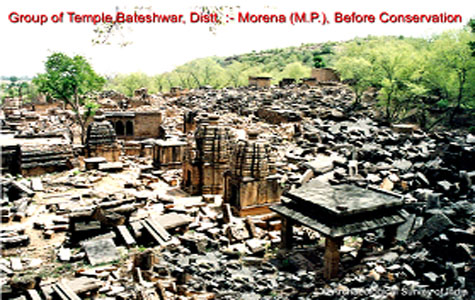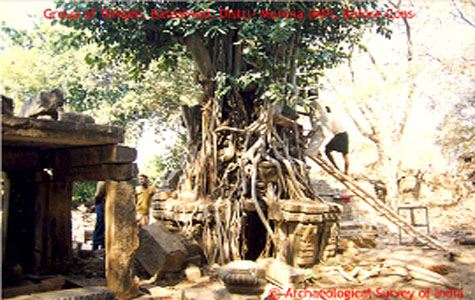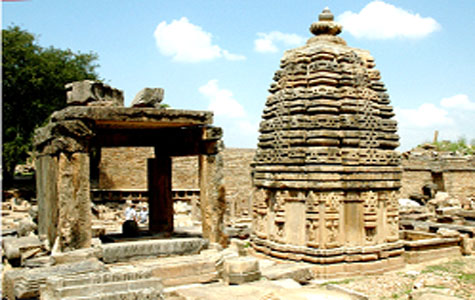

Bateshwar
Conservation & Preservation
Initially, the damaged temple structures serially from 1 to 6 were re-erected after thorough documentation and proper study and analysis. Foundations to all structures were provided.
In continuation of the previous years (2005-06)work the precariously placed temples, which are about 40 in number are being restored to its originality. Extensive research study has facilitated largely to restore these structures by using the fallen architectural members which are strewn all around. Besides, it was indeed a blessing in disguise for ASI that the unapproachable terrain of Chambal and the fear of dacoits had helped largely in preserving the architectural and sculptural components of the temple intact for such a long period.
Before

Before

After Conservation

Exposition of large number of temple remains on removing vegetation growth; soil and superfluous rubble have thrown light on the massive destruction of architecture belonging to post-Gupta period. Many factors could have responsible for such damages, such as water flow from the hillside, vegetation, and faunal activities. Of course the occurrence of an earthquake of large intensity cannot be ruled out. Platforms of various temples and the water tank have been reset by using the fallen architectural members. Location of a water tank well within the temple premises refers to sanctity and serenity of the place. To re-establish it's pristine beauty several conservation measures are being taken up. Several temples were cleared of its vegetation. Foundation of each structure is being strengthened. Missing architectural members of the sikhara portion of various structures are being reassembled after selecting the correct member lying in the precincts. Besides, mending of broken architectural members with the help of stainless steel dowels, pointing and water tightening of conserved structures etc are also in progress. The tank near the Bateshwar temple was conserved on the basis of architectural evidences available at the site.
Before

After Conservation

After Conservation

The temple has been rescued out of the octopus like grip of the tree. After cutting down the tree the ruined temple was dismantled and was re-erected by using the fallen architectural members. It is a pancha ratha temple
Further work In continuation of the previous years (2006-07)work the precariously placed temples, which are about 40 in number are being restored to its originality. Extensive research study has facilitated largely to restore these structures by using the fallen architectural members which are strewn all around.
Exposition of large number of temple remains on removing vegetation growth; soil and superfluous rubble have thrown light on the massive destruction of architecture belonging to Early Pratihara Period. Many factors could have been responsible for such damages, such as water flow from the hillside, vegetation, and faunal activities. Of course the occurrence of an earthquake of large intensity cannot be ruled out.To re-establish it's pristine beauty several conservation measures are being taken up. Several temples were cleared of its vegetation. Foundation of each structure is being strengthened. Missing architectural members of the sikhara portion of various structures are being reassembled after selecting the correct member lying in the precincts. Besides, mending of broken architectural members with the help of stainless steel dowels, pointing and water tightening of conserved structures etc have been undertaken. The tank near the Bateshwar temple was conserved on the basis of architectural evidences available at the site.Before

After Conservation

